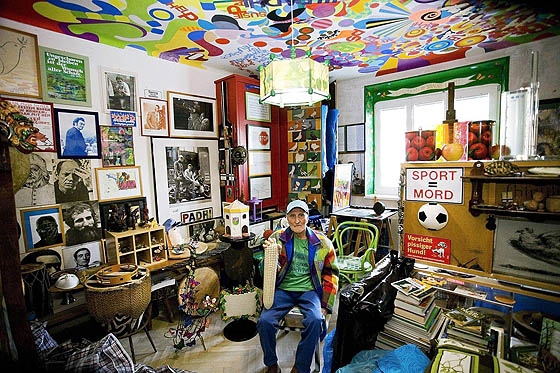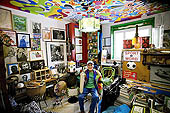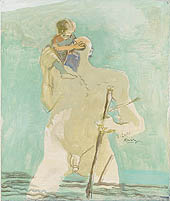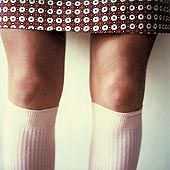
translated and summarized by: Liz Wollner-Grandville,
English summaries March 26 - April 9
Forum Frohner
Padhi Frieberger – The Splendour and Wretchedness of Modernism
16.10.2012 – 15.04.2012
By Margareta Sandhofer
Padhi Frieberger isn't a myth. And he's not a phantom. Padhi is simply there, completely real and quite present – provided he lets someone get close to him. He's just as real as his art. And he is active as never before and that in his best metier of his comprehensive art, in the staging, the staging of his works and himself. And it's always authentic.
He's also perfectly styled despite being over 80 years of age and his appearance is precise in every detail. Dressed in a light blue jeans jacket with a matching blue T-shirt, matching blue trousers and matching blue cap, his blue eyes sparkle at you, sometimes with a piercing look down the sharply cut nose – between the closely packed, properly ordered piles and stacks of his archive. Because of his frail health, he is now concentrating fully on the exact compilation of his painstakingly collected, extremely complex photographic documentation of all his activities and on documenting new texts and verbal ideas, his aphorisms. Because as he says: "I'm not a literary figure, I'm an artist who has something to say." And he has a lot to say - he always did, sometimes too much.
In the Krems exhibition, his early work, which sweepingly showed him as an unbelievably progressive pioneer, is also presented. It doesn't matter whether it's an early watercolour which reminds one of the Bauhaus style, pictures like those by Oskar Schlemmer, the object "o.T." of 1954 which in its still-life-like entity is related to the paintings of Giorgio Morandis and pre-empts material assemblage which is later exhibited under the term of object art. All the materials that Padhi Frieberger found, are integrated into his creations. What's trendy today as trash or throw-away art has its harbinger here. The object "o.T." from the cycle "The Reprocessing Object", a composition of sawn-up stools and a sawn-up table, is not dated however, but can be seen as an authentic early work from its condition and overall appearance (the collaged newspaper cuttings from 1945 also belong to this), namely on the level of Robert Rauschenberg's free-standing "Combines".
Before Padhi Frieberger could have known Rauschenberg’s art, it exhibited striking parallels. His paintings with applied everyday objects can be compared with Rauschenberg's "Combine Paintings", in both cases it has to do with three-dimensional painting that possesses a true character as opposed to illusionism. The collages are similarly unconventionally put together, colourful, satirical picture and text fragments. In both works every hierarchical arrangement, every genre-specific allocation is withheld. Instead, focus is laid on an unconventional genre and border-transgressing aspect, as well as a society-critical aspect. A good portion of Dadaism is always present in Frieberger’s oeuvre – and for many works the satirical or sarcastic title is, "the point is that it's not always so desperately serious."
However, in Rauschenberg's comparable objects, the convincing formalization and materiality of the open way of thinking of the free American scene definitely comes across. Frieberger has not always succeeded in liberating himself from the determining cultural narrowness of the Austrian post-war era. The ideally broad potential of the applicable irony is sometimes buried in the often-repeated plethora of the cynical arguments. To a certain extent, the struggle for artistic expression thwarts the development of a possible imaginary freedom of space. But there is a definite moment of opposition: original authenticity is always maintained in Padhi Frieberger's work as a distinctive and consequent quality. "My art is no gimmick, it is simply there."
In the transgressive artistic personality of Padhi Frieberger, life, political attitude and art are identical. This unit stands as a monolith, as nothing less than a hermetic complex in unyielding, vehement rebellion against encrusted social, political and market-oriented systems. The strict non-compliance of the art market and its – to date – tempting mechanisms is an implicit, tenacious and obligatory principle. Frieberger leads a fight against each of the structures limiting individuality with musical, picturesque, verbal artistic statements, with radical consequences in both public and private life: "My art is a very important political issue." "I also write today, but much more radically. That's necessary because everyone only acts placidly."
The diversity of Padhi Frieberger's creations, his relevance in an all-embracing context, can only be represented in fragments in an exhibition. However, what could – and should - be brought more into focus is the photographic work. He whom he permits to look into his photographic works bound in books will not only be surprised by the astonishing photographic talent, but will be deeply impressed; amazing the glance into "Padhi's Object Zone", amazing the glance into "Padhi's Habits". Padhi proves himself to be a brilliant photographer, the shots being as perfect in emotive theatrics as in still poetry. These are of artistic as well as historic significance, formidable documentation of his charismatic artistic personality in its complex facets; but above all, manifestations of a genial, shimmering production of his art as well as of his own person: the phenomena Padhi Frieberger in original authenticity, of timeless quality. "I profess to Modernism. I am a modern person, I don't let myself be corrupted by any regressive tendencies. Once modern – always modern!"
(The quotations have been taken from a conversation held on 22.03.12 in the artist's archives, for which I sincerely thank Padhi Frieberger.)
Forum Frohner
3504 Krems-Stein, Minoritenplatz 4
Tel: +43 (0) 2732/90 80 10
Fax: +43 (0) 2732/90 80 11
email: office@forum-frohner.at
www.forum-frohner.at
Opening hours: daily 11-17 h
MUSA
Beauty Contest
17.2. 12 – 16.05.12
by Charles Nebelthau
"Beauty contest", so the title of the exhibition in the MUSA, doubtless promises only
naive bikini girls with crowns and sparkling tears of joy. But it's clear to everyone else when glancing at Carina Bezzola’s performance costumes that this is more serious than things shown on TV.
The press release for the exhibition drastically illustrates our present life as passion under the dictatorship of beauty – "penetrating all the body's pores and every crack of the human psyche" – it's an enlightenment session about the dangers, if not the tyranny of beauty. One could giggle about the red-white straw buttocks on Katarina Schmidl ("A beautiful piece of Austria"). Maria Lassnig's self-portrait indicates a national auto-aggressive direction in its sub-title of Marie Antoinette's derisive nickname "The Austrian", if you're not prepared for the outlandishly meaty, crooked phallic-like evaginations. One could briefly hope that it were an exhibition about the agony of the Austrians, to find Austria beautiful, but that is a too provincial thought opposed to globality.
There's too much that looks ugly and not beautiful enough. "In the world we live in, what we know and what we don´t know are like Siamese twins inseparables existing in a state of confusion", says Muntean and Rosenblum's badly hung large canvas with beauties standing around lost in a landscape with the portentous sub-title - we are being warned. In the large hall you will find different visualizations of globally operable problems with dictatorial beauty – men who want to be women (Matthias Herrmann), and woman painting her nails, and a man with an absurd nose (Cindy Sherman), a girl doing gymnastics (Ulrike Lienbacher), people as jewels or in the jewels of a stringent ornament (Reshad Newsome, Andrea Freiberger, Sissi Farassat), poor people before and after a visit to the hairdresser (Mehmet Emir), the objectivity of the person as a photo model (Eva Chuong-Fox), a woman, staging a woman, that has staged herself as a man (Irene Andessner), a nude from behind which can only remind one blatantly of Man Ray’s Violon d´Ingres but which is described (Birgit Jürgenssen), the difficulties of folkloric apparel (Sula Zimmerberger), and more. The disturbing video cube by Maria Petschnig presents enormous possibilities for peculiar vicarious embarrassment – and with this, about half of the 26 represented positions are covered.
There's definitely something for everyone. The exhibition clearly shows that the problematic of beauty and its penetrating domination doesn't only exist worldwide, but is also pluralistic: some fight with the ugliness that determines their gender, weight, age and fortune and the others with the vulgarities that their taste imposes on them. Everyone feels like a victim somewhere, sometime. That's a nice offer, isn't it?
MUSA
1010 Vienna, Felderstraße 6-8, next to the Town Hall
Tel: +43 (0)1 4000 8400
Fax: +43 (0)1 4000 99 8400
E-mail: musa@musa.at
www.musa.at
Opening hours: Tue - Fri: 11:00 - 18:00, Thu: 11:00 - 20:00, Sat: 11:00 - 16:00 hours
Galerie Elisabeth und Klaus Thoman
Siegfried Anzinger – New pictures and sculptures
10.03.2012 – 05.05.2012
By Gesche Heumann
Painting is the film that sticks the pigmentation of the colours with the movements of the painter onto the canvas. The canvas orientates itself on the painter’s decision as to how large it should be. The painter forms the theatrical soul of the painting. The painting that can be seen on the canvas springs from the painter's head, glance and movement.
Sigmund Freud's reflections on the back room that we called the soul before we considered it wiser to call it the psyche were sometimes eye-opening to us regarding the statements made in art. The statements of the new pictures by Siegfried Anzinger – as depicted by their title, composition and figural settings – treat details of the story of the creation in different religious traditions, i.e. paradise appears next to the ancient Hades. Beside this appear Indians, naked and clothed, animistic, orgiastic and contemplative, even riding mopeds. One can possibly summarize the actions in the paintings as obscene stories but there are many pictures and accordingly, many actions. It's also possible to divide the pictures into grades of blasphemy or amounts of interwoven cultural quotations, statistically seen almost captivating. It might also be amusing to imagine that one were Sigmund Freud looking at the works of Siegfried Anzinger.
The paintings of Siegfried Anzinger are based on limewater colour. Dealing with this doesn't allow for any Sfumato or varnish and demands prima tempera painting like a classical fresco where paint is applied until it dries and when it begins to dry, it's too late. You can't make any transitions, can't show any natural shadows and depict a space within the contrasting expansion; space must be created through perspective. The light in such pictures is always clear and yet gives a unified sense of space – it corresponds to the colour of the sky, if the sky is visible. Anzinger's light moves in a shimmering, sandy green whose yellow lights are never vulgar, whose red tones make an anchoring point in the picture and whose forward and receding movements give the impression of odourless, dust-collecting, very flat plants whose leaves are very long, smooth and tender. It's not a glowing green, not genuinely credulous, more an Iceland pony-like green that chortles in a buzzing sort of way. It's not a green that becomes lush in the summer but it's an irrational, buoyant green. It'll last longer than spring's glamour.
Galerie Elisabeth und Klaus Thoman
1010 Vienna, Seilerstätte 7
Tel: + 43 1 512 08 40
E-mail: galerie@galeriethoman.com
www.galeriethoman.com
Opening hours: Tue-Fri 12-18, Sat 11-16 hours
Museum der Moderne Salzburg Mönchsberg
Wearing Skirts
18.02.2012 – 10.06.2012
By Goschka Gawlik
Since Modernism, the free language of fashion has often been compared with other great creations of other culture forms. More importantly, it especially crosses paths with the language of the applied arts, because fashion designers – as Barthes observed – are themselves constructors of significance, myths and pictures. The appropriate semiology is then used as a sales argument.
Today, fashionable clothes and their poetry flatter the individual. They augment the diverse expression of the personality, the joy of self-presentation and, in the extreme, fashion goes well beyond the borders of this function. These thoughts, as well as the advanced processes of presenting clothing in modern photography and sculptures are the plot of an extensive exhibition in the Museum of Modern Art in Salzburg, which has been put together from its own collection. Works by 76 artists, mainly from Austria, are currently being exhibited; they represent different generations ranging from Uli Aigner to Robert Zahornicky.
Anselm Kiefer marks the exhibition in the museum’s foyer-staircase with a sculptural horror creation: a white floor-length dress without straps and instead of the face, there is a gargantuan tangle of hair made of coarse, dark barbed wire.
The sign language of the clothing now becomes the mediator of larger categories giving structure to the exhibition "Wearing Skirts". The first one of these, "Skirt or Trousers", plays with the construction and interchangeability of the sexes visualized in several "unisex" pieces of clothing and decorative details. In 2000, Andrea Lumplecker exclusively photographed the knees of different models in segmented form, thereby proving that dualistic distinguishing criteria are in a crisis.
The artist specifically questions the expectations of sexual determination. Fashion as a masquerade ad nauseam is shown in Cindy Sherman’s early video work, Doll Clothes. Birgit Jürgenssen, on the other hand, seems very proud to wear her housewifely apron as a fetish. And the exhibition would not be complete without Valie Export's icon poster, the Aktionshose: Genitalpanik.
Fashion promises play, flirt and light-heartedness of the being. The theme of the second room is "Like Models", in which large formats by Eva Schlegel and Caroline Heider are presented. Schlegel underlines the purely superfluously fixed (fashion) culture with long-legged but blurred femininity. Through her individual photo-folding technique, Heider creates creatures rather than ideals of beauty.
Today, fashion functions fetishistically and is advertisement in itself. Its locations are boutique shop windows, magazines and online style pages. The completely artificially decorated shop windows with different, rather more staid than chic fashion, are presented in Peter Köllerer’s almost museum-like series of works "Architectures of Desire". Keeping pace with (western) fashion is strenuous and frustrating. Beat Streulis' photographic pictures illustrate the phenomena of eastern cultures, in which our style of clothing is so popular, through the exhausting shopping sprees of fashion-conscious Japanese in Tokyo's streets. "Dead Trousers" further tells us that the fashion system, in contrast to the art world, actually lies on the other side of life. While fashion swings continually between young, always new and indestructible, its wearers die. What's left of them are worn clothes that live on as relics or glamorous fetishes. Kaucyila Brooke reflects on this in her well-known photo work, Kathy Acker`s Clothes.
Clothes are also body sculptures that can continually be changed. They model the individual appearance of the person extravagantly, corpulently or moodily or they emphasize their affiliation with a social (sub)group or special careers. Here, the examples stretch from Diana Arbus’ school uniforms of the "Identical Twins" to photographs from the series Success by Hans Weiss, who shows New York business people as an unwilling, "faceless" army. Walter Seidl is somewhat less severe with a New York couple and documents in his series D&S the (apparent) reversal of the roles of the sexes by means of a co-ordinated common look.
The exhibition, which is rather sparsely decorated with sculptures, takes headless figures and sculptures by Erwin Wurm as evidence of the diverse themes and social configurations, which indicate that in the Salzburg collection, several deficits need to be remedied. Exhibitions of this sort always take place in the Museum of the Moderne without an opening ceremony and are not documented with a catalogue or publication, thereby omitting the curator's work and the results of his/her research. A pity in view of this notable and extensive exhibition, which could provide more about individual and less well-known artists if more theory and information was offered.
Museum der Moderne Salzburg Mönchsberg
5020 Salzburg, Mönchsberg 32
Tel: +43 / 662 / 84 22 20-403
Fax: +43 / 662 / 84 22 20-700
E-mail: info@mdmsalzburg.at
www.museumdermoderne.at
Opening hours: Tue to Sun So 10-18, Wed 10-20 hours
Mehr Texte von translated and summarized by: Liz Wollner-Grandville


 Teilen
Teilen




